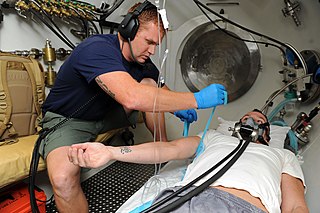
Decompression sickness is a medical condition caused by dissolved gases emerging from solution as bubbles inside the body tissues during decompression. DCS most commonly occurs during or soon after a decompression ascent from underwater diving, but can also result from other causes of depressurisation, such as emerging from a caisson, decompression from saturation, flying in an unpressurised aircraft at high altitude, and extravehicular activity from spacecraft. DCS and arterial gas embolism are collectively referred to as decompression illness.

Hyperbaric medicine is medical treatment in which an increase in barometric pressure over ambient pressure is employed increasing the partial pressures of all gases present in the ambient atmosphere. The immediate effects include reducing the size of gas embolisms and raising the partial pressures of all gases present according to Henry's law. Currently, there are two types of hyperbaric medicine depending on the gases compressed, hyperbaric air and hyperbaric oxygen.

Oxygen toxicity is a condition resulting from the harmful effects of breathing molecular oxygen at increased partial pressures. Severe cases can result in cell damage and death, with effects most often seen in the central nervous system, lungs, and eyes. Historically, the central nervous system condition was called the Paul Bert effect, and the pulmonary condition the Lorrain Smith effect, after the researchers who pioneered the discoveries and descriptions in the late 19th century. Oxygen toxicity is a concern for underwater divers, those on high concentrations of supplemental oxygen, and those undergoing hyperbaric oxygen therapy.
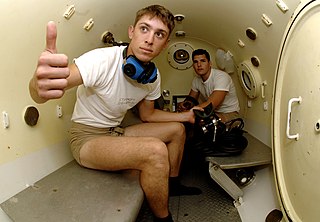
Diving medicine, also called undersea and hyperbaric medicine (UHB), is the diagnosis, treatment and prevention of conditions caused by humans entering the undersea environment. It includes the effects on the body of pressure on gases, the diagnosis and treatment of conditions caused by marine hazards and how aspects of a diver's fitness to dive affect the diver's safety. Diving medical practitioners are also expected to be competent in the examination of divers and potential divers to determine fitness to dive.
Rubicon Foundation, Inc. is a non-profit organization devoted to contributing to the interdependent dynamic between research, exploration, science and education. The foundation, started in 2002, is located in Durham, North Carolina and is primarily supported by donations and grants. Funding has included the Office of Naval Research from 2008 to 2010. Gibson, Dunn & Crutcher has provided pro bono services to assist in copyright searches and support.
The Undersea and Hyperbaric Medical Society (UHMS) is an organization based in the US which supports research on matters of hyperbaric medicine and physiology, and provides a certificate of added qualification for physicians with an unrestricted license to practice medicine and for limited licensed practitioners, at the completion of the Program for Advanced Training in Hyperbaric Medicine. They support an extensive library and are a primary source of information for diving and hyperbaric medicine physiology worldwide.
Peter B. Bennett was the founder and a president and CEO of the Divers Alert Network (DAN), a non-profit organization devoted to assisting scuba divers in need. He was a professor of anesthesiology at Duke University Medical Center, and was the Senior Director of the Center for Hyperbaric Medicine and Environmental Physiology at Duke. Bennett is recognized as a leading authority on the effects of high pressure on human physiology.

Constant weight without fins (CNF) is an AIDA International freediving discipline in which the freediver descends and ascends by swimming without the use of fins or without pulling on the rope or changing his or her ballast; only a single hold of the rope to stop the descent and to start the ascent is allowed. Constant weight without fins is the depth discipline of freediving that is most challenging, because of the physical effort needed to swim without assistance.

Capt. Edward Deforest Thalmann, USN (ret.) was an American hyperbaric medicine specialist who was principally responsible for developing the current United States Navy dive tables for mixed-gas diving, which are based on his eponymous Thalmann Algorithm (VVAL18). At the time of his death, Thalmann was serving as assistant medical director of the Divers Alert Network (DAN) and an assistant clinical professor in anesthesiology at Duke University's Center for Hyperbaric Medicine and Environmental Physiology.

Richard Rutkowski is a pioneer in the fields of hyperbaric medicine, diving medicine and diver training, especially in relation to the use of breathing gases.
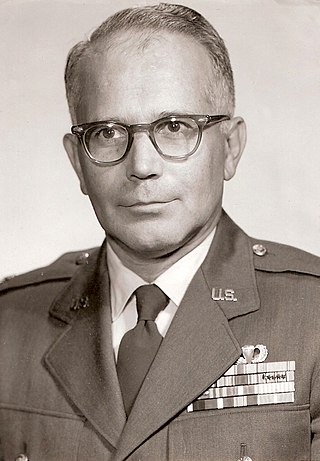
Colonel William Paul Fife USAF (Ret) was a United States Air Force officer that first proved the feasibility for U.S. Air Force Security Service airborne Communications Intelligence (COMINT) collection and Fife is considered the "Father of Airborne Intercept". Fife was also a hyperbaric medicine specialist who was known for his pioneering research on pressurized environments ranging from high altitude to underwater habitats. Fife was a Professor Emeritus at Texas A&M University.
National Board of Diving and Hyperbaric Medical Technology (NBDHMT), formally known as the National Association of Diving Technicians, is a non-profit organization devoted to the education and certification of qualified personnel in the fields of diving and hyperbaric medicine.
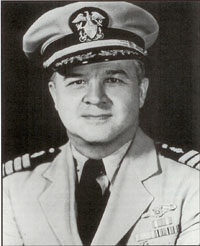
Captain Charles Wesley Shilling was an American physician who was known as a leader in the field of undersea and hyperbaric medicine, research, and education. Shilling was widely recognized as an expert on deep sea diving, naval medicine, radiation biology, and submarine capabilities. In 1939, he was Senior Medical Officer in the rescue of the submarine U.S.S. Squalus.
No-limit apnea is an AIDA International freediving discipline of competitive freediving, also known as competitive apnea, in which the freediver descends and ascends with the method of his or her choice. Often, a heavy metal bar or "sled" grasped by the diver descends fixed to a line, reaching great depths. The most common ascension assistance is via inflatable lifting bags or vests with inflatable compartments, which allow for rapid surfacing. The dives may be performed head-first or feet-first.
The European Underwater and Baromedical Society (EUBS) is a primary source of information for diving and hyperbaric medicine physiology worldwide. The organization was initially formed as the European Underwater and Biomedical Society in 1971 and was an affiliate of the Undersea Medical Society for several years. Its purpose is promoting the advancement of diving and hyperbaric medicine and the education of those involved in the field; EUBS provides a forum and a journal for exchange of information and promotes research into diving medicine.

Neal Pollock is a Canadian academic and diver. Born in Edmonton, Canada he completed a bachelor's degree in zoology; the first three years at University of Alberta and the final year at the University of British Columbia. After completing a master's degree he then served as diving officer at University of British Columbia for almost five years. He then moved to Florida and completed a doctorate in exercise physiology/environmental physiology at Florida State University.
Richard Deimel Vann is an American academic and diver.
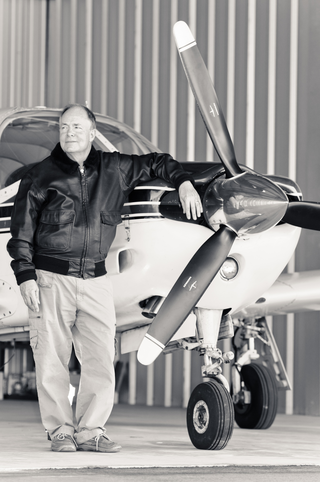
John R. Clarke is an American scientist, private pilot and author. He is currently the Scientific Director at the United States Navy Experimental Diving Unit (NEDU). Clarke is recognized as a leading authority on underwater breathing apparatus engineering.










